About precious metals
How to choose which metal is right for you and your partner
When it comes to choosing the right precious metal for your jewellery, there’s a bit more to it that simply ‘which colour?’
The right metal for you and your partner
Which metal is right for you and your partner?
When choosing between metals for heirloom-quality jewellery, the big three considerations are colour, strength and comfort (or wearability).
Which Colour?
If buying for yourself, you probably already know what you want, but if designing a ring that’s going to be a surprise, here are some simple pointers.
Take note of your partner’s favourite jewellery and accessories
If your partner wears a lot of yellow jewellery, go for yellow gold. Or if their jewellery is mostly ‘white’, go for either white gold, platinum or silver. And if it’s rose gold, there’s your answer.
Alternatively, if they don’t tend to wear much jewellery, you might get some clues from accessories like belt buckles, watches, bags and purses or even their phone case. If, despite your research, they seem to have no clear colour preference, talk to us and we will help you with the decision.
One other thing to consider when choosing the metal colour is the colour of the stones that will be set in the ring. (We can help you with that too.)
Strength
We almost always recommend platinum when high-value diamonds and gemstones are involved.
It’s the strongest and least likely to fail and the marginal extra cost is worthwhile insurance.
Gold, whilst the most popular jewellery choice, is also the softest and is more easily worn away than metals from the platinum family.
Wearability
In particular you need to consider skin allergies and reactions (see below).
Platinum is hypoallergenic, so a very safe choice if you or your partner are prone to skin reactions from contact with jewellery.
Platinum: What’s the big deal?
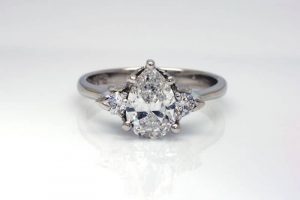
Because of its strength and resilience, platinum is the perfect choice for securing high-value gems like this trio of Argyle diamonds
Platinum is the “prestige” jewellery metal for both practical and financial reasons.
On a practical level, platinum is tougher than both gold and silver, making it ideal for setting valuable diamonds and gemstones.
Stones are much less likely to come loose from a well-made platinum setting.
‘Safer’ than white gold
A common alternative to platinum is white gold, but unlike white gold, when a diamond or gem is claw-set in platinum and one claw fails, the claws don’t act like they are ‘spring loaded’.
With platinum there’s a better chance that the gem or diamond won’t instantly fall from the setting should a breakage occur.
Low maintenance
Platinum is also lower maintenance than white gold.
Usually white gold is rhodium plated to make it very shiny. This coating does wear off over time.
Importantly, gold erodes whereas platinum displaces. This means a platinum ring will maintain its original weight whereas a gold ring will gradually reduce in weight.
If you want to create an heirloom piece, platinum is the white metal to choose.
More expensive, but not by much
A platinum ring will cost you more than a gold ring — and for good reason.
Platinum can be more difficult for jewellers to work with. It’s currently marginally cheaper per gram than gold but is a denser (heavier) metal.
This means you need more of it by weight to make a ring of the same size and design.
If you’re looking for a white metal engagement ring, particularly one with claw setting, we always recommend spending the extra few hundred dollars on platinum.
Palladium: What is it?
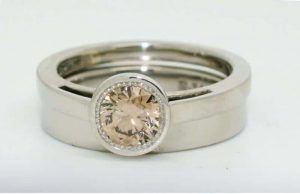
Argyle Cognac diamond set in recycled palladium with a matching palladium wedding band
From time to time you’ll hear palladium mentioned in the fine jewellery world. Palladium is a noble (inert) white metal and member of the platinum family. It shares many characteristics with platinum – including being hypoallergenic.
Durable and radiant bright white
Palladium offers a more radiant white than (un-plated) white gold.
With a weight similar to fine silver, it also has a lower specific gravity, meaning that it doesn’t have the same ‘heft’ as other metals.
An expensive alternative
Whilst palladium is technically an alternative to platinum, silver and white gold in jewellery making, at the moment it’s a very expensive option that, on balance, doesn’t stack up against the others.
All metals will get scratched
Whilst platinum, palladium, silver and white gold are beautiful and durable white metals, they can scratch. In fact, all precious metals scratch!
How much they get scratched depends on how you care for your rings and it’s important to accept this.
You must take care when putting your hands in abrasive substances such as soil or sand. Precious jewellery and hard physical labour tend not to go well together.
Gold: Your options
When it comes to gold, you have a few different options.
In Australia, the standard for jewellery is either 9 carat or 18 carat. (24 carat gold is ‘pure’, making it too soft for rings.)
Regional differences
In the USA and Asia, 14-carat is a popular choice and you’ll find 10 carat commonly mentioned – particularly with US-based suppliers.
The difference between 9, 10, 14 and 18 carat is the amount of added alloys. 18 carat gold has fewer alloys and is ‘softer’ than 9 carat, making it easier to work.
There’s also a noticeable difference in colour. 18 carat yellow gold is more ‘yellow’ and brighter than 9 carat yellow gold for example. While 14 carat is somewhere between.
Colour choices
When it comes to colour, you have three choices: yellow, white and rose gold.
As discussed earlier, the yellow of yellow gold varies with carat. 9 carat gold tends to be a bit more of a pale yellow than 18 carat.
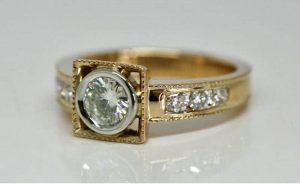
Moissanite in a platinum bezel set in 18 carat recycled yellow gold with white accent diamonds on the shoulders
18 carat rose gold has a reddish, pinkish colour, with 9 carat being even more so (because of the higher percentage of copper in the alloy) …
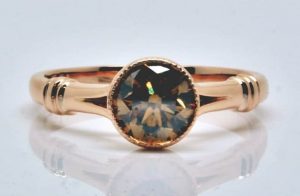
Argyle Cognac diamond set in 18 carat recycled rose gold
And un-plated white gold with a high palladium content looks a bit like silver when polished. Rhodium plated white gold looks super white.
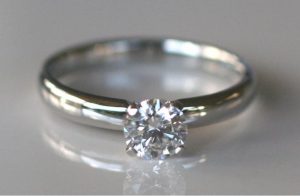
Argyle white diamond set in a rhodium-plated, recycled 18 carat white gold ring
Note: The rhodium coating will wear off over time and will require reapplication. Frequency depends on how much of the ring comes into contact with hard surfaces.
As for cost, 18 carat white gold is more expensive than 18 carat yellow gold (at the time of writing – Sept, 2022) by about $20 per gram.
The recycled white gold we use is nickel free and has a high (12%) palladium content making it a much whiter gold in appearance. The other benefit is it doesn’t pose the same allergy issues as gold alloyed with nickel.
Why not silver?
Even though a lot of jewellery is made with silver (that is very often recycled in origin), when it comes to fine handmade jewellery, it isn’t a good choice on its own – at least not in terms of economics.
Labour cost means hand making is uneconomic
Whilst silver is certainly a lot cheaper than gold or platinum (where you might pay $90 — $100 for a gram of gold, you’ll pay only $6 – $10 for a gram of silver), that’s where the savings end.
Labour cost is the ‘killer’.
In terms of time, it takes just as long to hand make a ring out of silver as it does to make one out of gold.
It’s a bit like spending too much money doing up a house – you’ll never get the value back again.
Too ‘cheap’ for fine quality jewellery
To get something hand made in silver you’ll pay up to ten times more than a similar retail item, so the value isn’t there.
For gold and platinum, the gap between mass-made retail jewellery and hand-made bespoke jewellery is much, much smaller. So the small premium you might pay is well worth it to get something that’s unique and exactly what you want.
Another downside with silver is that it tarnishes and needs regular polishing. You can rhodium plate it, but that’s expensive given the value of the base metal.
That said, never say never …
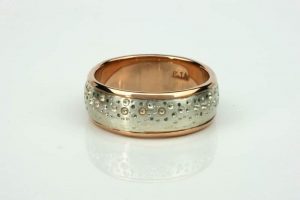
18 carat recycle rose gold band with a patterned silver sleeve
This bespoke wedding features a silver ‘sleeve’ around an recycled 18 carat rose gold band.
Custom made for a keen surfer, the pattern on the silver sleeve represents bubbles. Our client also happened to really like silver and how its patina develops over time.
When combined with a precious metal like gold, and if you’re doing it for reasons other than to save money, there’s still a place for silver.
Environmentally a good choice
As a final word, whilst silver doesn’t rate very highly in terms of prestige, where it does shine is its relative carbon cost.
All recycled precious metals rate much better than their ‘new’ counterparts, but silver is that much better again. Recycled silver has a carbon footprint two and a half times smaller than the next best option, recycled gold. (You can read in more detail about this here.)
Allergies and skin reactions
In our experience, problems with contact dermatitis are most often caused by contaminants (like soap) being trapped between the ring and the wearer’s finger. However this isn’t always the case.
Allergic Reactions
When metal allergies do arise, they’re almost always associated with gold and silver jewellery, both of which contain relatively high percentages of alloy metals.
The most frequent cause of allergic reactions is nickel, which is most commonly alloyed with white gold. (Other common metals alloyed with gold are palladium, copper and silver.)
As a guideline, the Jewellers Association of Australia recommends the following:
- A piece of jewellery that will be in close contact with external surface of the skin (such as a ring, bracelet or necklace) should be no more than 3% nickel.
- A piece of jewellery that will be in contact with internal skin – like an earring or belly ring post – should contain no more than 0.05% nickel.
18 carat gold is 75% pure, meaning that 25% of the metal is made up of other alloy metals.
As both are hypoallergenic, platinum and palladium are your safest choices if you or your partner suffer skin reactions to jewellery. If you must have white gold, insist on a nickel-free gold alloy.
Design to minimise contamination

The undercarriage on this 18 carat recycled yellow gold ring, whilst elaborate, is open and easy to keep clean and dry.
If you or your partner are prone to skin reactions, one way to reduce the potential for future problems is to design your ring (or rings) so you reduce the likelihood of contaminants like soap, cosmetics and food becoming trapped and staying in constant contact with your skin.
Principally this means minimising the number of small cavities and hollows on the inside of the ring.
If your design calls for an elaborate undercarriage for the gem setting, try to keep it open to allow air flow and make it easier to keep clean.
Ready to start designing the perfect ring or other jewellery piece?
If you’re ready to get started, give us a call or drop us a line. We’d love to help you turn your ideas into reality.
Our Privacy Policy | Terms & Conditions
© 2018 Ethical Jewellery Australia.
All Rights Reserved.
ABN: 3810 6233 196

